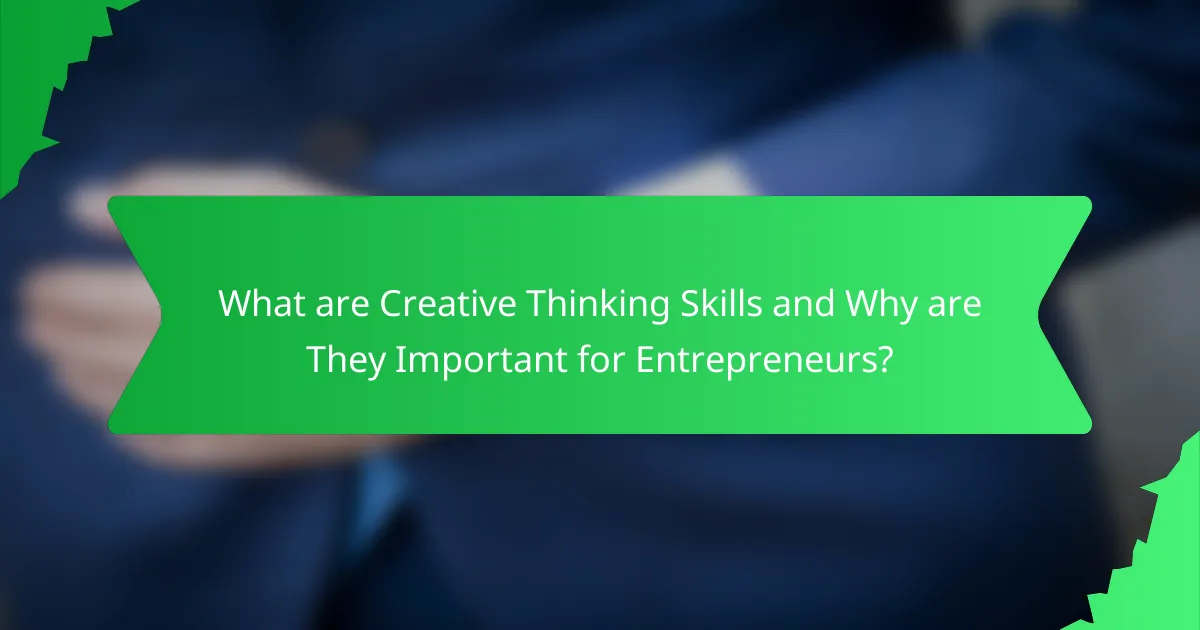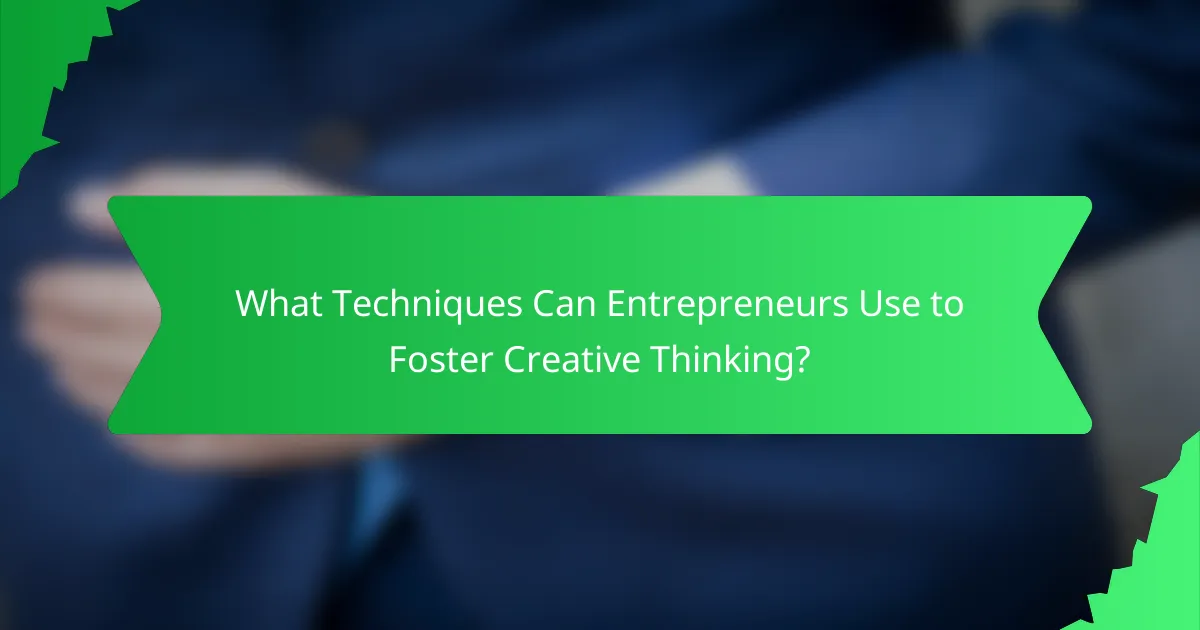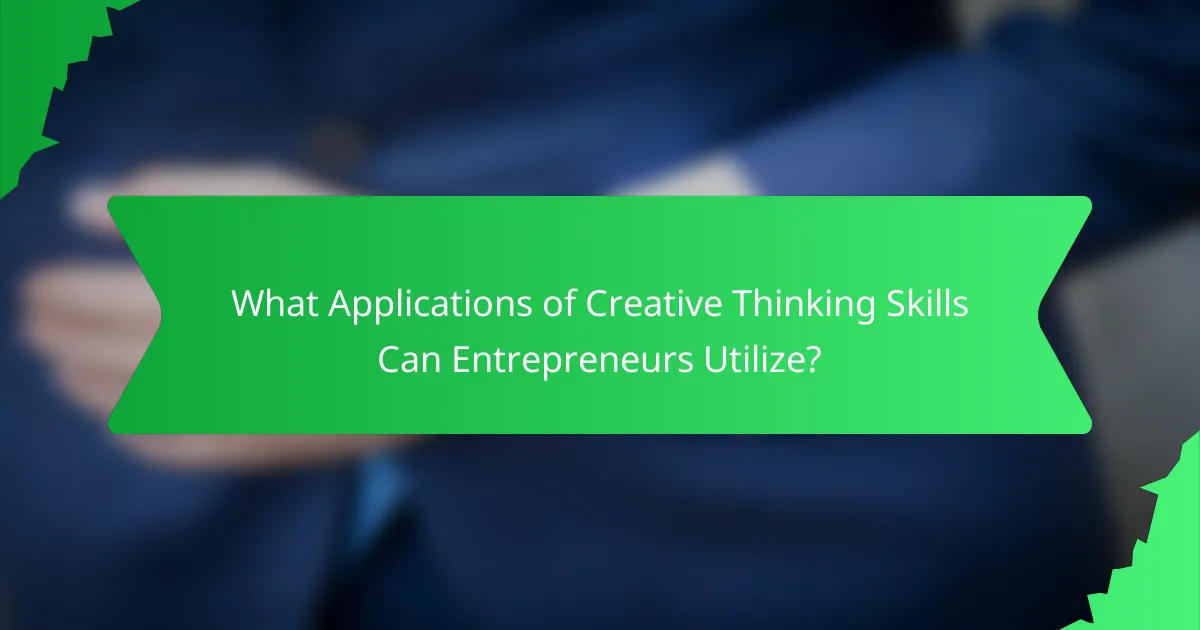Creative thinking skills are crucial for entrepreneurs, enabling them to generate innovative ideas and solutions that lead to business growth. This article explores the significance of these skills in problem-solving, product development, and marketing strategies, emphasizing their role in identifying opportunities and fostering adaptability in a competitive market. Key techniques for enhancing creative thinking include brainstorming, mind mapping, and encouraging a culture of experimentation, all of which contribute to increased idea generation and collaboration. The article also highlights the positive impact of diverse teams and structured creative processes on entrepreneurial success, supported by studies linking creativity to higher growth rates and profitability.

What are Creative Thinking Skills and Why are They Important for Entrepreneurs?
Creative thinking skills are the ability to generate innovative ideas and solutions. These skills enable entrepreneurs to approach problems from unique angles. They facilitate the development of new products and services. Creative thinking also enhances adaptability in a rapidly changing market. Entrepreneurs with strong creative skills can identify opportunities others may overlook. This leads to competitive advantages and business growth. According to a study by the World Economic Forum, creativity is among the top skills needed for future job markets. Thus, fostering creative thinking is essential for entrepreneurial success.
How do Creative Thinking Skills impact entrepreneurial success?
Creative thinking skills significantly enhance entrepreneurial success. These skills enable entrepreneurs to generate innovative ideas and solutions. Innovative ideas can differentiate a business in competitive markets. For instance, companies like Apple and Tesla have thrived due to their creative approaches. Additionally, creative thinking fosters adaptability in changing environments. Entrepreneurs who think creatively can pivot their strategies effectively. Research indicates that 72% of entrepreneurs attribute their success to creative problem-solving abilities. This skill set also encourages collaboration and team dynamics, leading to more effective execution of ideas. Overall, creative thinking is a crucial driver of entrepreneurial achievement.
What specific challenges do entrepreneurs face that require creative thinking?
Entrepreneurs face challenges such as market competition, resource constraints, and evolving consumer preferences that require creative thinking. Market competition demands innovative strategies to differentiate products and services. Resource constraints often limit budgets, necessitating cost-effective solutions. Evolving consumer preferences require adaptability in product development and marketing approaches. Additionally, regulatory changes can present unforeseen obstacles, prompting creative compliance strategies. According to a study by the Kauffman Foundation, 90% of entrepreneurs cite adaptability as crucial for success. This highlights the importance of creative problem-solving in navigating these challenges effectively.
How can creative thinking differentiate entrepreneurs in a competitive market?
Creative thinking can differentiate entrepreneurs in a competitive market by enabling innovative solutions and unique value propositions. This approach allows entrepreneurs to identify gaps in the market that others might overlook. For instance, a study by the Harvard Business Review found that companies fostering creativity saw a 20% increase in revenue. Creative thinkers can adapt their business models swiftly in response to market changes. They often generate novel ideas that lead to distinctive products or services. This differentiation can create a loyal customer base. Additionally, creative entrepreneurs are more likely to embrace risk, leading to potentially higher rewards. Overall, creative thinking equips entrepreneurs with the tools to stand out in crowded markets.
What are the key components of Creative Thinking Skills?
The key components of creative thinking skills include flexibility, originality, elaboration, and critical thinking. Flexibility allows individuals to adapt their thinking to new situations or perspectives. Originality involves generating unique ideas that are not commonly found. Elaboration refers to the ability to expand on ideas and develop them further. Critical thinking enables individuals to analyze and evaluate ideas effectively. These components work together to enhance problem-solving and innovation. Research shows that individuals with strong creative thinking skills can better navigate challenges and seize opportunities in entrepreneurship.
What techniques can enhance creative thinking abilities?
Techniques that can enhance creative thinking abilities include brainstorming, mind mapping, and lateral thinking. Brainstorming encourages the generation of numerous ideas without immediate judgment. This technique fosters a free flow of thoughts, leading to innovative solutions. Mind mapping visually organizes information, helping to connect ideas and concepts. This method enhances understanding and retention of complex information. Lateral thinking involves approaching problems from new angles. It encourages breaking conventional thought patterns to discover unexpected solutions. Research shows that these techniques can significantly improve problem-solving skills and creativity. For instance, a study by Osborn in 1953 highlighted how brainstorming can increase idea generation by 50%.
How do cognitive and emotional aspects influence creative thinking?
Cognitive and emotional aspects significantly influence creative thinking. Cognitive aspects include mental processes such as perception, memory, and problem-solving. These processes help individuals generate ideas and evaluate their feasibility. Emotional aspects, like mood and motivation, also play a critical role. Positive emotions can enhance creativity by broadening thinking and encouraging exploration. Research shows that individuals in a positive emotional state produce more creative solutions. For instance, a study by Isen et al. (1987) found that participants who experienced positive emotions generated more innovative ideas. Thus, both cognitive and emotional factors are essential for fostering creative thinking.

What Techniques Can Entrepreneurs Use to Foster Creative Thinking?
Entrepreneurs can foster creative thinking through techniques like brainstorming, mind mapping, and encouraging a culture of experimentation. Brainstorming allows individuals to generate a wide range of ideas without judgment. Mind mapping visually organizes thoughts, helping to identify connections between concepts. Encouraging experimentation allows entrepreneurs to test ideas in a low-risk environment. Implementing regular feedback sessions promotes reflection and improvement. Diverse teams enhance creativity by combining different perspectives. Additionally, setting aside time for creative activities can stimulate innovative thinking. These techniques are supported by studies indicating that structured creative processes lead to increased idea generation and problem-solving efficiency.
How can brainstorming sessions be optimized for better results?
Brainstorming sessions can be optimized by establishing clear objectives. Defining specific goals helps participants focus their ideas. Encouraging diverse perspectives enhances creativity. Inviting individuals from different backgrounds fosters unique insights. Setting a time limit can increase urgency and idea generation. Research indicates that time constraints can boost creative output. Utilizing structured techniques, such as mind mapping or the SCAMPER method, can guide discussions effectively. These methods provide frameworks that stimulate innovative thinking. Lastly, creating a comfortable environment encourages open communication. A relaxed setting promotes free expression of ideas.
What roles do collaboration and diversity play in brainstorming?
Collaboration and diversity enhance brainstorming by fostering a wider range of ideas and perspectives. Collaborative environments encourage participants to build on each other’s thoughts. This interaction leads to innovative solutions that may not emerge in solitary settings. Diversity introduces varied experiences and viewpoints, enriching the brainstorming process. Research shows that diverse teams outperform homogenous ones in creative tasks. A study by Woolley et al. (2010) found that groups with diverse members generate more creative ideas. Therefore, both collaboration and diversity are crucial for effective brainstorming outcomes.
How can entrepreneurs create an environment that encourages open idea sharing?
Entrepreneurs can create an environment that encourages open idea sharing by fostering a culture of trust and respect. This involves actively promoting open communication channels. Regular brainstorming sessions can be organized to facilitate idea exchange. Providing platforms for anonymous feedback can also help in voicing concerns. Encouraging diverse teams enhances creativity and perspective. Recognizing and rewarding contributions boosts morale and participation. Implementing flexible workspaces can promote collaboration. Research shows that organizations with open communication have higher employee satisfaction, leading to increased innovation.
What role does problem-solving play in creative thinking?
Problem-solving is essential to creative thinking as it enables individuals to identify and address challenges effectively. Creative thinking often involves generating innovative ideas to overcome obstacles. When faced with a problem, individuals utilize creative thinking to explore various solutions. This process encourages divergent thinking, where multiple possibilities are considered. Research indicates that effective problem-solving enhances creativity by fostering an open mindset. According to a study by Runco and Acar (2012), individuals who engage in problem-solving tasks demonstrate higher levels of creative output. Thus, problem-solving directly contributes to the development and application of creative thinking skills.
How can entrepreneurs apply creative problem-solving techniques?
Entrepreneurs can apply creative problem-solving techniques by utilizing brainstorming sessions to generate diverse ideas. This method encourages free thinking and the exploration of unconventional solutions. They can also implement design thinking, which focuses on understanding user needs and iterating solutions based on feedback. Another effective technique is the use of mind mapping, allowing entrepreneurs to visually organize thoughts and identify connections between concepts.
Additionally, entrepreneurs can adopt the SCAMPER method, which prompts them to Substitute, Combine, Adapt, Modify, Put to another use, Eliminate, and Reverse elements of a problem. This structured approach fosters innovation. Engaging in collaborative problem-solving with diverse teams can also enhance creativity. Different perspectives lead to richer solutions.
Research shows that companies employing creative problem-solving techniques outperform competitors in innovation and adaptability. According to a study by the Harvard Business Review, organizations that prioritize creative thinking see a 30% increase in productivity.
What are some real-life examples of successful problem-solving in entrepreneurship?
Airbnb successfully solved the problem of short-term lodging by creating a platform for homeowners to rent their spaces. This innovation emerged during an economic downturn in 2008. Founders Brian Chesky and Joe Gebbia initially struggled to pay rent. They decided to offer air mattresses in their apartment to attendees of a design conference. This idea grew into a global business model, allowing individuals to monetize their extra space.
Another example is Starbucks, which faced declining sales in 2008. CEO Howard Schultz recognized the need to enhance customer experience. He closed stores for a day to retrain baristas on brewing espresso. This decision revitalized the brand and improved customer satisfaction, leading to increased sales.
Lastly, Tesla addressed the challenge of electric vehicle range anxiety. The company developed a network of Supercharger stations to provide fast charging. This infrastructure alleviated consumer concerns about electric vehicle usability. As a result, Tesla became a leader in the electric vehicle market.

What Applications of Creative Thinking Skills Can Entrepreneurs Utilize?
Entrepreneurs can utilize creative thinking skills in various applications. These include problem-solving, product development, and marketing strategies. Creative thinking enables entrepreneurs to identify unique solutions to challenges. It fosters innovation in creating products that meet market needs. Entrepreneurs can also leverage creative thinking for effective branding and storytelling. This helps in differentiating their offerings in a competitive landscape. Furthermore, brainstorming sessions can enhance team collaboration and idea generation. Studies show that companies valuing creative thinking see higher growth rates and profitability.
How can creative thinking be applied to product development?
Creative thinking can be applied to product development by generating innovative ideas and solutions. It allows teams to explore unconventional concepts. This process can lead to unique product features that differentiate them in the market. For instance, brainstorming sessions encourage diverse perspectives. Techniques like mind mapping facilitate the visualization of ideas. Prototyping enables rapid testing of concepts, refining them based on feedback. Research shows that companies that foster creative thinking see a 20% increase in product success rates. This highlights the tangible benefits of integrating creativity into product development.
What are the steps to incorporate creative thinking into the product design process?
Define creative thinking as the ability to generate innovative ideas. The first step is to establish a clear problem statement. This guides the creative process by focusing on specific needs. Next, gather a diverse team to encourage varied perspectives. Diverse teams can produce a wider range of ideas. Then, conduct brainstorming sessions to generate multiple solutions. These sessions should be free from criticism to foster open expression. Afterward, prioritize ideas based on feasibility and impact. Use criteria like market demand and production costs for evaluation. Prototype the top ideas to visualize concepts. Prototyping helps identify potential issues early. Finally, test and refine the prototypes based on user feedback. Iterative testing ensures the final product meets user needs effectively.
How can entrepreneurs use creative thinking to identify market gaps?
Entrepreneurs can use creative thinking to identify market gaps by exploring unconventional ideas and perspectives. This approach allows them to see opportunities that others may overlook. Techniques such as brainstorming, mind mapping, and lateral thinking can stimulate innovative solutions. Research shows that diverse thinking leads to more effective problem-solving. A study by the Harvard Business Review found that teams with varied backgrounds generate higher-quality ideas. Additionally, entrepreneurs can analyze consumer feedback to uncover unmet needs. This data-driven insight can reveal significant market gaps. By combining creativity with analytical skills, entrepreneurs can effectively pinpoint areas for innovation.
How does creative thinking influence marketing strategies?
Creative thinking significantly influences marketing strategies by enabling innovative solutions and unique approaches. It allows marketers to develop distinctive brand identities. This differentiation helps attract and retain customers. Creative thinking fosters the generation of new ideas for campaigns. These campaigns can resonate more effectively with target audiences. Research indicates that companies prioritizing creativity outperform competitors in growth. For instance, a study by Adobe found that creative companies are 3.5 times more likely to achieve significant revenue growth. This correlation highlights the importance of creative thinking in shaping effective marketing strategies.
What innovative marketing techniques can stem from creative thinking?
Innovative marketing techniques that stem from creative thinking include experiential marketing, content marketing, and influencer collaborations. Experiential marketing engages consumers through immersive experiences, enhancing brand connection. Content marketing focuses on storytelling to create value and build relationships with audiences. Influencer collaborations leverage trusted voices to reach targeted demographics effectively.
For instance, a study by Event Marketer found that 70% of consumers prefer experiences over products. This highlights the effectiveness of experiential marketing. Additionally, HubSpot reports that companies with strong storytelling in their content marketing see 300% more engagement. These techniques demonstrate how creative thinking can lead to impactful marketing strategies.
How can storytelling enhance marketing efforts through creative thinking?
Storytelling can enhance marketing efforts by creating emotional connections with audiences. It allows brands to convey their values and mission in a relatable way. Engaging narratives can capture attention and foster brand loyalty. Creative thinking in storytelling enables unique approaches that differentiate a brand from competitors. For instance, brands like Nike use storytelling to inspire customers, making their marketing memorable. Research shows that stories are 22 times more memorable than facts alone. This data underscores the effectiveness of storytelling in marketing strategies. Ultimately, storytelling combined with creative thinking leads to more impactful marketing campaigns.
What best practices can entrepreneurs adopt to enhance their creative thinking skills?
Entrepreneurs can enhance their creative thinking skills by adopting specific best practices. Regular brainstorming sessions can generate diverse ideas. Engaging in collaborative work fosters innovative solutions. Embracing a growth mindset encourages learning from failures. Seeking feedback from peers can provide new perspectives. Setting aside time for reflection allows for deeper insights. Exploring different industries can inspire unique approaches. Lastly, practicing mindfulness can enhance focus and creativity. These practices are supported by studies indicating that diverse thinking leads to better problem-solving outcomes.
How can regular practice and reflection improve creative thinking?
Regular practice and reflection enhance creative thinking by fostering cognitive flexibility and idea generation. Engaging in activities that stimulate creativity, such as brainstorming or problem-solving exercises, allows individuals to explore diverse perspectives. Reflection on these activities helps to consolidate learning and identify effective strategies. Studies show that regular creative practice can lead to increased originality in thought. A 2018 study by Forth and colleagues found that individuals who practiced creative tasks consistently showed significant improvement in their creative output. This indicates that both practice and reflection are essential for developing and refining creative skills.
What resources are available for entrepreneurs to develop their creative skills?
Entrepreneurs can develop their creative skills through various resources. Online courses on platforms like Coursera and Udemy offer structured learning. Workshops and seminars provide hands-on experience and networking opportunities. Books such as “Creative Confidence” by Tom Kelley and David Kelley explore innovative thinking. Podcasts focusing on entrepreneurship often discuss creative strategies and insights. Additionally, joining entrepreneurial communities or forums fosters collaboration and idea exchange. These resources collectively enhance creative thinking capabilities essential for entrepreneurial success.
The main entity of the article is creative thinking skills for entrepreneurs. The article outlines the importance of these skills in generating innovative ideas, solving complex problems, and enhancing adaptability in competitive markets. It discusses specific challenges entrepreneurs face that require creative solutions, the key components of creative thinking, and techniques to foster these skills. Additionally, it highlights how creative thinking can differentiate entrepreneurs in the marketplace and improve their marketing strategies, ultimately contributing to business growth and success.
